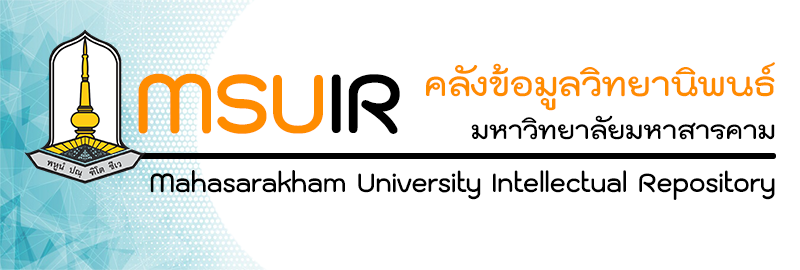Please use this identifier to cite or link to this item:
http://202.28.34.124/dspace/handle123456789/2762| Title: | The Development of Instructional Model Based on Flipped Learning by using Technology-Based to Enhance Digital Literacy of Undergraduate Students in Faculty of Education, Rajabhat University การพัฒนารูปแบบการเรียนการสอนกลับด้านโดยใช้เทคโนโลยีเป็นฐานเพื่อเสริมสร้างการรู้ดิจิทัลสำหรับนักศึกษาระดับปริญญาตรีคณะครุศาสตร์ มหาวิทยาลัยราชภัฏ |
| Authors: | Wachira Morachat วชิระ โมราชาติ Thapanee Seechaliao ฐาปนี สีเฉลียว Mahasarakham University Thapanee Seechaliao ฐาปนี สีเฉลียว thapanee.see@msu.ac.th thapanee.see@msu.ac.th |
| Keywords: | รูปแบบการเรียนการสอน การพัฒนาการเรียนการสอน การเรียนการสอนกลับด้าน การรู้ดิจิทัล การเรียนรู้โดยใช้เทคโนโลยี Instructional Model The Development of Instructional Instructional Model Flipped Learning Digital Technology-based learning |
| Issue Date: | 31 |
| Publisher: | Mahasarakham University |
| Abstract: | The purposes of the study were to 1) investigate the current state, problems, and good practice, 2) develop an instructional model, and 3) examine the effects of using the created model concerning digital literacy derived from the experiment and control groups.
The research process was divided into three phases: 1) studying the current state and good practices, 2) developing an instructional model, and 3) examining the effects of using the created model. The samples were the first-year undergraduate students enrolling in the Innovation and Information Technology for Educational Communication and Learning subject in the 2nd semester of the 2022 academic year. They were divided into 2 groups including 30 samples for an experiment group and another 30 for a control group. Statistics utilized included percentages, arithmetic means, standard deviations, and t-tests for data analysis.
The research findings were as follows:
1. The opinions of the instructors and students on the current state of teaching and learning through the technology-based approach via the teaching and learning methods, materials, and evaluation and measurement showed an overall lower level of practice. As for good practice, several suggestions from the experts were derived. Including the principles of the model emphasizing the use of technology as a basis for learning. Set learning objectives that are clear and measurable. The teaching and learning process of the model emphasizes learning in which students participate and interact continuously, using media, technology, and learning resources that learners can access.
2. The developed model to enhance digital literacy of undergraduate students in the Faculty of Education of Rajabhat University consisted of 6 elements: 1. model components including 1) model principle, 2) model objective, 3) materials, technology and learning resources, and 4) measurement and evaluation; 2. teaching and learning approaches containing 1) in-class teaching and learning, and 2) online teaching and learning; 3. flipped learning processes are comprised of 6 steps: 1) making understanding of the learning process, 2) studying from technological media and learning sources, 3) reflecting and producing questions. 4) exchanging knowledge, 5) producing a workpiece, and 6) evaluating; 4. learning by a technology-based approach consists of 1) information search, 2) communication, 3) workpiece development, 4) presentation, 5) classroom management, and 6) data and information storage; 5. digital literacy contains 1) having digital and information knowledge background, 2) accessing, 3) managing, 4) integrating, 5) communicating, 6) creating, 7) being aware, and 8) evaluating; and 6. Measurement and evaluation include 1) a digital literacy competency test and 2) a survey of students’ satisfaction. An overall appropriateness of the developed model evaluated by experts resulted in the highest level (x̅ = 4.65, S.D. = 0.58) whereas its overall quality certified by the experts was found to be at a higher level (x̅ = 4.35, S.D. = 0.43).
3. The results of the developed model utilization indicated that 1) after learning through the instructional model, the students’ mean scores of digital literacy competency were found to be higher at a significant level of .05; 2) mean scores of digital literacy of the experiment and control groups were found significantly different at the level of .05. and 3) the students’ satisfaction of the developed instructional model was found to be at overall most satisfied level (x̅ = 4.81, S.D. = 0.22). การวิจัยนี้มีวัตถุประสงค์เพื่อ 1) ศึกษาสภาพปัจจุบันและแนวปฏิบัติที่ดีเกี่ยวกับการจัดการเรียนการสอนกลับด้านโดยใช้เทคโนโลยีเป็นฐานเพื่อเสริมสร้างการรู้ดิจิทัล สำหรับนักศึกษาระดับปริญญาตรี คณะครุศาสตร์ มหาวิทยาลัยราชภัฏ 2) พัฒนารูปแบบการเรียนการสอนฯ และ 3) ศึกษาผลการใช้รูปแบบฯ ด้านการรู้ดิจิทัลของกลุ่มทดลองและกลุ่มควบคุมที่เรียนโดยการเรียนการสอนแบบปกติ มีขั้นตอนการดำเนินการ 3 ระยะ คือ 1. ศึกษาสภาพปัจจุบันและแนวปฏิบัติที่ดี 2. พัฒนารูปแบบการเรียนการสอนฯ และ 3. ศึกษาผลการใช้รูปแบบ ตัวอย่าง ได้แก่ นักศึกษาชั้นปีที่ 1 ที่ลงทะเบียนเรียนในรายวิชานวัตกรรมและเทคโนโลยีสารสนเทศเพื่อการสื่อสารการศึกษาและการเรียนรู้ ภาคเรียนที่ 2/2565 จำนวน 2 กลุ่ม ได้แก่ กลุ่มทดลอง จำนวน 30 คน และกลุ่มควบคุม จำนวน 30 คน สถิติที่ใช้ ได้แก่ ร้อยละ ค่าเฉลี่ย ส่วนเบี่ยงเบนมาตรฐาน และการทดสอบที ผลการวิจัย พบว่า 1. ความคิดเห็นของอาจารย์และนักศึกษาต่อสภาพปัจจุบันในการจัดการเรียนการสอนโดยใช้เทคโนโลยีเป็นฐาน ด้านวิธีการและกิจกรรมการเรียนการสอน ด้านสื่อการเรียนการสอน และด้านการวัดประเมินผล โดยรวมอยู่ในระดับน้อย และความคิดเห็นของผู้เชี่ยวชาญต่อแนวปฏิบัติที่ดีเกี่ยวกับการจัดการเรียนการสอนกลับด้านได้แก่ หลักการของรูปแบบเน้นการนำเทคโนโลยีมาเป็นฐานในการเรียนรู้ กำหนดวัตถุประสงค์การเรียนรู้ที่ชัดเจนและสามารถวัดผลได้ กระบวนการเรียนการสอนของรูปแบบเน้นการเรียนรู้ที่ผู้เรียนมีส่วนร่วมและมีปฏิสัมพันธ์กันอย่างต่อเนื่อง ใช้สื่อ เทคโนโลยีและแหล่งเรียนรู้ที่ผู้เรียนสามารถเข้าถึงได้ 2. รูปแบบการเรียนการสอนกลับด้านโดยใช้เทคโนโลยีเป็นฐานเพื่อเสริมสร้างการรู้ดิจิทัลสำหรับนักศึกษาระดับปริญญาตรี คณะครุศาสตร์ มหาวิทยาลัยราชภัฏ มี 6 ด้าน ได้แก่ 1. องค์ประกอบของรูปแบบฯ มี 5 องค์ประกอบ ได้แก่ 1) หลักการของรูปแบบ 2) วัตถุประสงค์ของรูปแบบ 3) กระบวนการจัดการเรียนการสอน 4) สื่อ เทคโนโลยีและแหล่งเรียนรู้ และ 5) การวัดและประเมินผล 2. การจัดการเรียนการสอน มี 2 ด้าน ได้แก่ 1) การเรียนในชั้นเรียนและ 2) การเรียนนอกชั้นเรียนแบบออนไลน์ 3. ขั้นตอนการจัดการเรียนรู้ มี 6 ด้าน ได้แก่ 1) ทำความเข้าใจกระบวนการเรียนรู้ 2) ศึกษาจากสื่อเทคโนโลยีและแหล่งเรียนรู้ 3) สะท้อนคิดและบันทึกคำถาม 4) แลกเปลี่ยนความรู้ 5) ผลิตผลงาน และ 6) ประเมินผล 4. การเรียนรู้โดยใช้เทคโนโลยีเป็นฐาน มี 6 ประเภท ได้แก่ 1) การสืบค้นข้อมูล 2) การติดต่อสื่อสาร 3) การพัฒนาผลงาน 4) การนำเสนอ 5) การจัดการชั้นเรียน และ 6) การจัดเก็บข้อมูล 5. การรู้ดิจิทัล มี 8 ด้าน ได้แก่ 1) พื้นฐานความรู้ดิจิทัลและสารสนเทศ 2) การเข้าถึง 3) การจัดการ 4) การบูรณาการ 5) การสื่อสาร 6) การสร้างสรรค์ 7) การตระหนักรู้ และ 8) การประเมิน 6. การวัดและประเมินผล มี 2 ด้าน ได้แก่ 1) แบบวัดการรู้ดิจิทัล และ 2) แบบสอบถามความพึงพอใจของผู้เรียน สำหรับการประเมินความเหมาะสมของรูปแบบการเรียนการสอนโดยผู้เชี่ยวชาญ พบว่า โดยรวมอยู่ในระดับมากที่สุด มีค่าเฉลี่ย (x̅= 4.65, S.D. = 0.58) และผลการประเมินเพื่อรับรองคุณภาพของรูปแบบการเรียนการสอนโดยผู้ทรงคุณวุฒิ พบว่า มีความเหมาะสมโดยรวมอยู่ในระดับมาก โดยมีค่าเฉลี่ย (x̅ = 4.35, S.D. = 0.43) 3. ผลการใช้รูปแบบการเรียนการสอนกลับด้านโดยใช้เทคโนโลยีเป็นฐานเพื่อเสริมสร้างการรู้ดิจิทัล พบว่า 1) นักศึกษาที่เรียนรู้ตามรูปแบบมีคะแนนเฉลี่ยของการรู้ดิจิทัลหลังเรียนสูงกว่าก่อนเรียน อย่างมีนัยสำคัญทางสถิติที่ระดับ .05 2) การรู้ดิจิทัลของนักศึกษาที่ใช้รูปแบบการเรียนการสอนฯ ของกลุ่มทดลองกับการเรียนการสอนปกติของกลุ่มควบคุม แตกต่างกันอย่างมีนัยสำคัญทางสถิติที่ระดับ .05 3) ความพึงพอใจของนักศึกษาที่มีต่อการเรียนรู้ตามรูปแบบ โดยภาพรวมอยู่ในระดับมากที่สุด โดยมีค่าเฉลี่ย (x̅ = 4.81, S.D. = 0.22) |
| URI: | http://202.28.34.124/dspace/handle123456789/2762 |
| Appears in Collections: | The Faculty of Education |
Files in This Item:
| File | Description | Size | Format | |
|---|---|---|---|---|
| 61010561007.pdf | 5.94 MB | Adobe PDF | View/Open |
Items in DSpace are protected by copyright, with all rights reserved, unless otherwise indicated.

